|
January 1948 Radio-Craft
 [Table of Contents] [Table of Contents]
Wax nostalgic about and learn from the history of early electronics.
See articles from Radio-Craft,
published 1929 - 1953. All copyrights are hereby acknowledged.
|
Dr. Allen Du Mont played a huge role in making television
practical because of the improvements he made to the cathode ray tube (CRT). Prior
to his work, the lifespan of a CRT was measured in tens of hours, and they were
expensive, so their use was limited to special military and research applications.
Du Mont's interest in "wireless" began at an early age, and he earned his commercial
radio operator's license at the age of 14 (in 1915). He designed and produced oscillographs
(aka oscilloscopes) that incorporated his CRTs. His involvement in the television
industry was a natural evolution and extension of the work done in related industries.
The DuMont Television Network was formed in 1942,
rivaling the established CBS and NBC. This article by Dr. Du Mont describing
the accomplishments of his company in establishing the first live East Coast-to-Midwest
live broadcasts and his efforts in providing affordable televising equipment to
local TV stations appeared in a 1948 issue of Radio-Craft magazine. A year
later DuMont TV Network completed the first coaxial cable installation between the
two locations. Note this comments in his article regarding manufacturing television sets
affordable to the general public: "Deft-fingered girls took the place of clumsier
males in wielding screw drivers and wrenches, pliers and wire strippers, soldering
irons and delicate connections."
Nation-Wide Television is Now in the Making
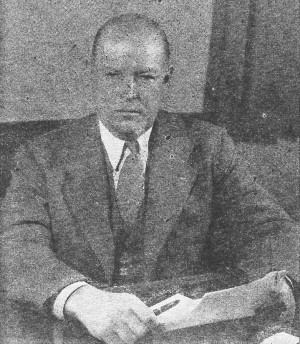
Allen B. Du Mont is a television pioneer largely responsible
for the commercialization of the cathode-ray tube and oscilloscope and president
of the Allen B. Du Mont Labs., Inc., manufacturers of television receivers
and transmitters, cathode-ray tubes, and oscilloscopes; owners of Du Mont network
with Du Mont-John Wanamaker studios and Stations WABD (New York) and WTTG (Washington).
By Dr. Allen B. Du Mont
Sooner or later, and probably sooner than generally expected, it will be immaterial
whether you live in New York or Pumpkin Center so far as satisfactory television
entertainment is concerned. For in due course television will become nationwide.
Smaller cities and rural areas will have their local telecasting services. Topflight
television programs originating in leading centers will be piped to dozens and later
hundreds of telecasting stations dotting this nation from coast to coast, following
in the footsteps of the great broadcasting networks. Nationwide telecasting will
spell nation-wide sale of television receivers. Realization of that dream is already
in the making.
That the commercialization of television has been slow, no one can deny. The
end of 1947 still saw telecasting services concentrated in a mere handful of leading
centers - New York, Philadelphia, Washington, Schenectady-Albany, Chicago, St. Louis,
Los Angeles, Detroit, and Cleveland. Fifteen stations were operating in those metropolitan
areas. However, 56 more telecasting stations were authorized and under construction,
so that a total of 41 cities and areas should shortly be enjoying visual programs.
Meanwhile, at the receiving end, there were less than 10,000 television sets
in use at the start of 1947. The majority were rendering yeoman service in bars
and grills, restaurants and clubs, and in other public places, while the homes boasting
television entertainment were to all intents and purposes public places too, so
far as immediate neighbors and friends were concerned. But during the year the leading
manufacturers got their production lines rolling. Deft-fingered girls took the place
of clumsier males in wielding screw drivers and wrenches, pliers and wire strippers,
soldering irons and delicate connections. Between 125,000 and 150,000 sets were
built and delivered last year, plus an unknown number of miscellaneous kit-assembled
receivers as well as receivers put together by local custom-set builders. Therefore
we can accept the fact that 1947 definitely dates the birth of commercialized as
distinguished from experimental television. From here on we can expect rapid expansion
and extension. Television is at last on its way!
So far, television has been concentrated in the 6 metropolitan areas chosen by
the pioneer telecasters - New York, Philadelphia, Washington, Schenectady-Albany,
Chicago, and Los Angeles-c-plus the newcomers in Detroit, St. Louis, and Cleveland
just starting on their telecasting career. It is particularly significant that 79%
of television set production in 1947 went into the New York metropolitan area, leaving
only minor allotments to other areas already enjoying telecasting service. This
means that even the enormous increase in production anticipated for 1948 - perhaps
topping a million units if general business conditions remain good - will still
fall far short of meeting the demands of the old and new telecasting areas.
The Telecasting Range
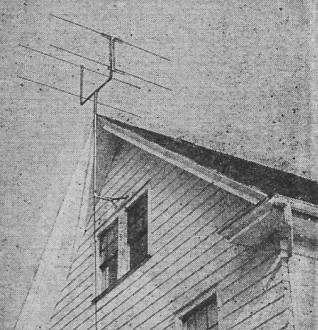
Two-deck television antenna with reflector, commonly used in
remote, receiving locations.
That leading metropolitan areas will continue to forge ahead with their telecasting
stations goes without saying. Broadcasters, newspapers, department stores, theatrical
interests, and others are willing and ready to step in with telecasting services
as and when the proposition looks like a money-maker.
Until recently, however, limited service range was taken for granted. The would-be
telecaster figured on a reliable coverage of 25 miles radius, and perhaps another
25 miles thrown in for good measure. Potential audiences were figured within such
concentric circles. The economics of station investment, operation, and anticipated
returns were worked out on that basis. Television engineers themselves were insistent
that, given an elevation of around 500 feet for the transmitting antenna to dominate
the surrounding terrain, 25 to 50 miles was good coverage. The city folks and those
in the suburbs could take satisfactory television service for granted. But rural
areas were quite apt to be out of luck. Perhaps television was not for them.
Fortunately, more recent telecast experiences have broadened the horizons. The
3 telecasting stations in New York City - WNBT (National Broadcasting) atop the
Empire State Tower, with about a 1,300-foot elevation; WCBW (Columbia Broadcasting)
atop the Chrysler Building, 950-foot elevation; and WABD (Du Mont) atop 515 Madison
Avenue, 700-foot elevation - are being received as a regular thing at distances
up to 75 miles and beyond. Thus an enormous rural area about this great city is
covered by television programs.
Better aerials, as well as television receivers of higher sensitivity, have increased
telecast coverage. At the transmitting end, improved antennas such as the bat-wing
turnstile have been introduced, beaming the radiated signal in the horizontal plane
instead of dissipating it into the sky where it can do little or no good so far
as the remote television receiver is concerned.
By such concentration, the new transmitting aerials are now stepping up radiated
power gain from 3 to over 9 times by actual measurement. In other words, a 5-kw
transmitter now has the effective signal strength of an earlier 15- to 45-kw transmitter.
Such tremendous gain is reflected in higher signal strength at the receiving aerial,
which in turn provides brighter, better contrasted images, and good sound reproduction,
especially at remote points.
Meanwhile, considerable progress is being made with receiving aerials. The earlier
simple dipole with or without reflector is making way for stacked dipoles and even
an impressive array of dipoles of different sizes to cover television and FM bands
from the lowest to the highest frequencies - 44 to 216 megacycles. Some aerials
are masterpieces of pipe-fitting, far more conspicuous than the conventional dwelling
that supports them.
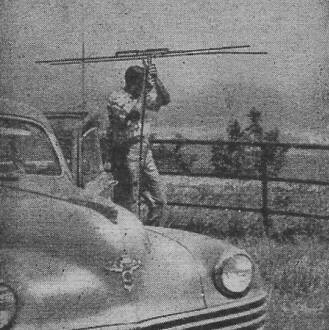
All New York City's television stations were picked up in the
Catskills with this antenna.
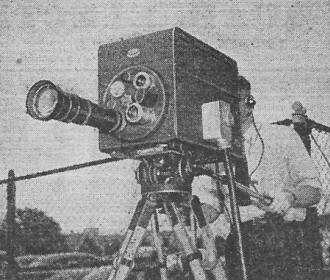
Orthicon camera for small telecasters - can be used both for
outside pickup and studio work.
More care is being taken with transmission lines, especially the matching of
impedances of line and set input, for minimized losses. In Du Mont receiver installations,
the Cosgrove folded dipole with supplementary members or "horns" has proven satisfactory
in covering all television and FM bands in most localities, although some of the
more elaborate stacked dipoles and reflectors of assorted sizes will doubtless be
required in stretching telecasting coverage beyond our customary service ranges.
Dr. Thomas T. Goldsmith, Director of Research for the Du Mont Laboratories, and
the writer, occasionally accompanied by others interested in such studies, have
done considerable work in long-distance television reception. The author's Chrysler
sedan has been equipped with a gasoline-driven a.c. generator, collapsible pipe
mast, and various aerial rigs, as well as a standard television receiver, to make
receiving tests at remote points. The New York television stations have been received
in the Catskills and the Poconos, at Montauk Point on the end of Long Island, and
at Atlantic City, or over distances consider-ably beyond 75 miles. Various types
of dipoles have been tried, as well as rhombic antennas which, while requiring more
space than can be provided in crowded localities, compensate for such handicaps
by requiring relatively little elevation. Some of the results of these long-distance
television reception experiments will soon be released.
Some distance from the nearest movie theater, away from the numerous distractions
of the city, with plenty of evening time to spare, certainly the rural family is
the ideal television audience. And television engineers intend to include that group
in the metropolitan area of television.
The Remoter Areas
But what of the small town-the secondary city - the trading center which means
so much to the surrounding rural area but does not rate among the so-called metropolitan
centers? Will television come to these spots, too?
Until this past year, the telecasting investment was considered well up in the
six figures - and we mean all dollars and no cents. We talked glibly of a quarter
to half a million dollars for a telecast transmitter and associated equipment. That's
a lot of money. So much that only monied individuals or organizations could even
think of going into the telecasting. business, and then only in leading metropolitan
areas with large populations to justify the program sponsor's money.
Yet there are a dozen or more small towns and secondary areas for every leading
city and primary metropolitan area. The writer's organization soon sensed this situation
when approached by individuals and organizations from small centers who had some
money to invest but not the sums being talked about for large cities. Quite evidently
this telecasting proposition had to be cut down to the right size for the smaller
telecasters. So the engineers got to work boiling down telecasting equipment until
the irreducible minimum was attained for satisfactory telecasting service over a
range of 15 to perhaps 50 miles, depending on transmitting antenna height and the
nature of the surrounding terrain.
Such a boiled-down telecasting setup has been developed by the writer's organization.
At a total investment well under $100,000, including all essential camera, movie
pickup, control, audio, lighting, transmitting, high-efficiency antenna and tower,
and even test equipment, the telecaster is soon ready for business. The 2 image
orthicon cameras are used for studio live-talent pickups, movie pickups, and outside
work. The 500-watt video and 250-watt audio transmitters provide adequate coverage
at the start, and can be added to later by way of r.f. amplifiers, ultimately attaining
a dual transmitter of 5-kw video and 2.5-kw audio rating, or even higher.
Here at last is basic gear. The small telecaster can get on the air. The investment
is kept at a minimum while the commercial angle is being worked out over the first
year or two. Video programs can be placed on the air while local folks install their
television receivers. As the audience grows, the telecaster can step up his transmitting
and studio facilities with a minimum of obsolescence. The whole scheme makes for
a sound economic balance. Certainly the basic television gear, as exemplified by
this Du Mont television package and corresponding offerings of RCA, G-E, and other
builders of equipment, is attracting widespread" attention and will soon be opening
up many areas that otherwise would be passed over by telecasters.
The Program Problem
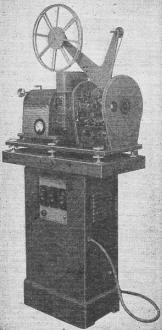
A movie machine designed to project images which are picked up
by a television camera.
So far, we have discussed getting; satisfactory television signals to large and
small cities, urban and rural areas, near and remote locations, alike. But what
about the programs such signals will carry? After all, it's the show that counts.
Television productions are relatively costly. Live-talent studio presentations,
to be worthy of a real audience, call for skilled performers, writers, directors
and scenery artists in front of the camera, and for cameramen, control-room operators,
microphone-boom, dolly and lighting attendants, and others behind it. Television
shows call for actors who can memorize their lines. Obviously, once the performance
is underway, there can be no interruption in the action. There can be no retakes.
There can be no prompting. That means many more hours of rehearsing than actual
time on the air. It all adds up to real money.
There has been a tendency during 1947 for some leading telecasters to subordinate
their studio activities to outside pickups such as sports, news events, and "magazine"
features. At least such programs "just happen" and can be televised as they are
found. To be sure, sporting events often call for handsome payments far the television
rights, but the popularity of televised sporting events is such that there is no
dearth of sponsors to foot the bill.
From the metropolitan centers, then, must come most of the studio productions
and the major sporting events as well as the big news events. This means a television
network. Such a network can be either of the as-it-happens kind or of the recorded-on-film
kind, just as in sound broadcasting there is the actual network and in addition
the electrical transcription.
Already the beginnings of the television network of tomorrow have been made.
The A. T. & T. coaxial cable between New York and Washington, with Philadelphia
and Baltimore along the way, already is being used for network purposes, mainly
by NBC and Du Mont. Such coaxial cables are being extended in the Middle Atlantic,
South, and Mid-West States. Nevertheless, many gaps still remain to be closed before
coast-to-coast telecasting can be even approximated. Meanwhile, several organizations
seeking less costly means of piping syndicated television programs have turned to
ultra-high-frequency radio relaying, notably G-E and Philco, while the Bell System
is supplementing its coaxial lines with radio relays. The NBC-G-E tie-up between
New York and the Schenectady-Albany area is made in 4 radio-relay jumps-from the
Empire State Building to Mount Beacon to Round Top (in the Catskills) to Helderberg
Mountain (near Schenectady) and then into the main G-E transmitter, the radio relaying
transmitters being strictly automatic or non-attended. It may be that these relay
transmitters may serve local telecasting stations along the route in the future,
branching out the network. Philco in Philadelphia has been retransmitting WNBT (New
York) programs by means of relay transmitters.

Earth contour and line of sight along General Electric's New
York-Schenectady relay route.
In the matter of television networks, however, there is a time factor quite as
well as distance. The important news event doesn't wait upon the convenience of
the television audience. Most news events occur during the day, yet television audiences
gather in the evening. Consequently, such news events must be recorded on special
film, and telecast at such times as meet with the convenience and pleasure of the
television audience. Much of the syndicated program material is bound to be handled
by special television films from here on. Please note that word "special." Already
television is developing its own film-recording technique. Leading telecasters have
their own film camera crews. Most of the films are of the 16-mm size, for it has
been found that this small film does just about as well as the more cumbersome and
costly 35-mm theater film.
Means are available for filming programs directly off the monitor screens. Such
recordings have heretofore been used mainly "for the files," or for studying program
techniques and performances in considerable detail. They are now good enough to
be used for syndicating purposes. Thus telecasts originating in metropolitan studios
or remote pickups may be available to affiliates of a group or network within a
matter of hours or days.
So much for the big-city stuff which. the smaller telecaster will want to handle.
There never will be a scarcity of local programs. Certainly the football game between
the local high school team and that in the adjoining town always carries greater
weight than a big-league game. The telecaster will want to cover such local happenings
either by direct telecasting or by 16-mm film recordings for transmission during
evening hours. Prominent citizens will appear before camera and mike in the studio.
Amateur players will jump at the chance of being televised. The local television
station will be to the community what its local newspaper has ever been - the local
pride and joy.
So again the writer points out that eventually it will be immaterial whether
you live in New York or Pumpkin Center so far as satisfactory television entertainment
is concerned. In due course television must become nation-wide. That dream is well
along toward realization.
Posted October 22, 2019
|















